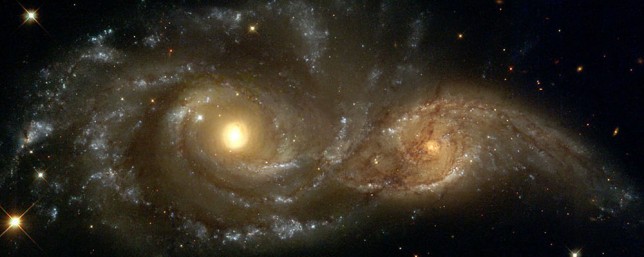Overview
The Department of Astronomy offers undergraduate and graduate instruction in a wide variety of fields, including theoretical and observational astrophysics; infrared, optical, and radio astronomy; galactic structure and dynamics of stellar systems; high-energy astrophysics and cosmology; star and planet formation; and spectroscopy. A considerable amount of research and teaching related to astronomy is done in other units at UC Berkeley, including the Physics Department, Earth and Planetary Science, Space Science Laboratory, and the Lawrence Berkeley National Laboratory. Various professors in the Chemistry, Mathematics, Statistics, and Engineering departments have an active interest in astronomy and are available for consultation.
Facilities
Many instruments are available to students and staff, including two 10-meter telescopes at the Keck Observatory on Mauna Kea in Hawaii; 30-inch, 40-inch, and 120-inch telescopes at Lick Observatory; a 16-element millimeter-wave interferometer in Southern California; the PAPER Array in South Africa; and a 30-inch telescope at Leuschner Observatory (near the campus). Laboratories are available for the development of radio, infrared, and optical instruments for the precise measurement of images and spectra. For further information regarding these resources, see the Facilities page on the department's website.
Physics-Astronomy Library
The Physics-Astronomy Library is located in 351 Physics North. The Physics-Astronomy Library has approximately 95,000 volumes available (on campus and at the NRLF) and 700 journal subscriptions.
Astronomy Reading Room
The Astronomy Reading Room is located in 229 Campbell Hall and contains a selection of useful books and journals. For further information, see the Reading Room Catalog.
Organized Research Units
The Radio Astronomy Lab is involved with many instruments and projects.
The Theoretical Astrophysics Center includes faculty, research scientists, postdoctoral researchers, and students working on a wide variety of problems in theoretical astrophysics.
The Center for Integrative Planetary Science is involved in many research projects including the ongoing Extrasolar Planet Search, astrobiology, and research into planetary composition and formation.
Other Research Projects and Opportunities
For further information on other research projects and opportunities, including faculty research publications, see the Research page of the department's website.
Undergraduate Program
Astrophysics: BA, Minor
Graduate Program
Astrophysics: PhD
Faculty and Instructors
* Indicates this faculty member is the recipient of the Distinguished Teaching Award.
Faculty
Steven Beckwith, Professor. Origins of life, cosmology, star formation, planet formation.
Research Profile
Joshua Bloom, Professor. Machine learning, gamma-ray bursts, supernovae, time-domain astronomy, data-driven discovery.
Research Profile
* Eugene Chiang, Professor. Planetary science, theoretical astrophysics, dynamics, planet formation, circumstellar disks.
Research Profile
Courtney Dressing, Professor. Searching for small, potentially habitable exoplanets orbiting nearby stars, characterizing planet host stars to improve stellar and planetary parameters, Investigating the dependence of planet occurrence on stellar and planetary properties.
Research Profile
* Alexei V. Filippenko, Professor. Supernovae, active galaxies, black holes, gamma-ray bursts, expansion of the universe.
Research Profile
Raymond Jeanloz, Professor. Planetary geophysics, high-pressure physics, national and international security, science-based policy.
Research Profile
Paul Kalas, Adjunct Professor. Planets, astronomy, Telescopes, Science Ethics.
Research Profile
Daniel Kasen, Associate Professor. Theoretical and computational astrophysics.
Research Profile
Richard I. Klein, Adjunct Professor. Astronomy, star formation, interstellar medium, coupled radiation-gas dynamical flows, supernova shockwaves, hydrodynamic collisions, high-energy astrophysics, photon bubble oscillations, hydro dynamics.
Research Profile
Jessica Lu, Associate Professor. Adaptive optics, Astrometry, Black holes, Galactic Centers, Optical/infrared instrumentation, Resolved Stellar Populations, Star and Cluster Formation, The Stellar Initial Mass Function.
Research Profile
Wenbin Lu, Assistant Professor. High-energy astrophysics, compact objects, black holes, time-domain astronomy, gravitational wave sources, fast radio bursts, plasma physics, hydrodynamics.
Chung-Pei Ma, Professor. Astrophysics, dark matter, cosmology, formation and evolution of galaxies, cosmic microwave background radiation.
Research Profile
Raffaella Margutti, Associate Professor. Electromagnetic counterparts to gravitational-wave sources, compact-object mergers, stellar explosions, massive stellar eruptions.
Burkhard Militzer, Associate Professor. Saturn, structure and evolution of Jupiter, and extrasolar giant planets.
Research Profile
Aaron Parsons, Associate Professor. Radio astronomy instrumentation; cosmic reionization; digital signal processing; experimental cosmology; formation and evolution of large-scale cosmic structure (baryon acoustic oscillations and dark energy).
Research Profile
Uros Seljak, Professor. Theoretical, computational and data analysis in astrophysics and cosmology.
Research Profile
Daniel R. Weisz, Associate Professor. Near-field cosmology, galaxies, resolved stellar populations, stellar evolution, star formation, the stellar initial mass function.
Research Profile
Martin White, Professor. Cosmology, formation of structure in the universe, dark energy, expansion of the universe, cosmic microwave background, quasars, redshift surveys.
Research Profile
Lecturers
Gaspard Duchene, Lecturer. Star and planet formation, stellar multiplicity, protoplanetary disks, debris disks, high-angular resolution techniques, radiative transfer modeling in circumstellar disks.
Research Profile
Emeritus Faculty
Jonathan Arons, Professor Emeritus. Astrophysics, compact astrophysical objects, Neutron Stars, ionized plasmas, cosmic rays, magnetized accretion disks, black holes pulsars, magnetic fields, planets.
Research Profile
Gibor Basri, Professor Emeritus. Astronomy, low mass stars, brown dwarfs, star formation, T Tauri stars, stellar magnetic activity, starspots.
Research Profile
Leo Blitz, Professor Emeritus. Astronomy, formation of galaxies, evolution of galaxies, conversion of interstellar gases, milky way, dark matter, dwarf galaxies, interstellar medium, high velocity clouds, hydrogen atom.
Research Profile
C. Stuart Bowyer, Professor Emeritus. Space astrophysics.
Research Profile
Marc Davis, Professor Emeritus. Astronomy, physical cosmology, large scale velocity fields, structure formation in the universe, maps of galactic dust.
Research Profile
Imke De Pater, Professor Emeritus. Radio, planetary science, infrared, observations.
Research Profile
Reinhard Genzel, Professor Emeritus. Physics, existence and formation of black holes in galactic nuclei, the nature of the power source, the evolution of (ultra)luminous infrared galaxies, gas dynamics, the fueling of active galactic nuclei, the properties evolution of starburst galaxies.
Research Profile
James R. Graham, Professor Emeritus. Adaptive optics, infrared instrumentation, large telescopes.
Research Profile
Carl E. Heiles, Professor Emeritus. Astronomy, interstellar medium, itsmorphology, supernovas, interstellar magnetic fields, Eridanus superbubble, interstellar gases.
Research Profile
Christopher F. Mckee, Professor Emeritus. Astrophysics, interstellar medium, formation of stars, astrophysical fluid dynamics, computational astrophysics, astrophysical blast waves, supernova remnants, interstellar shocks.
Research Profile
William J. (Jack) Welch, Professor Emeritus. Formation of stars, dark dust clouds, Michelson interferometer array, and Allen telescope array.
Research Profile
